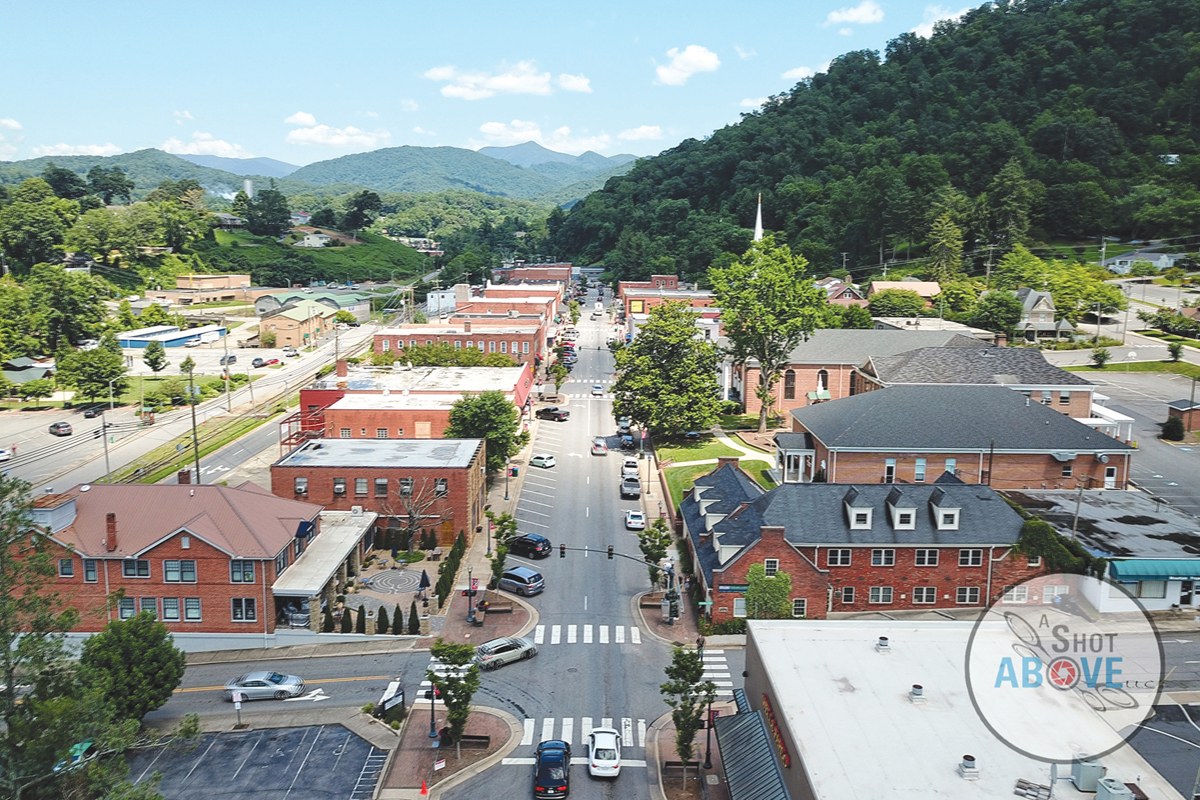Sylva moves forward on public restrooms
 Downtown Sylva. Allen Newland photo
Downtown Sylva. Allen Newland photo
To save money after bids for the downtown public restroom project came in over budget, Sylva will move forward without installing the intended solar panels.
“Solar panels can be added at any time during the lifespan of this structure, probably cheaper than this contractor would do it,” said Public Works Director Jake Scott. “This is the most significant cost savings of any of the other items.”
The lowest bid the Town of Sylva received for the public restrooms was higher than what it had budgeted for the project. This prompted a value engineering discussion during the Oct. 26 Town Council meeting to determine how the town could change the restroom plans to save money.
“It’s very standard to negotiate with the low bidder before entering into a contract,” said Scott.
The bathrooms are set to be built beside the railroad on Mill Street in a style that is reminiscent of the old railroad depot. The town received four bids and selected one from Cinderella Partners. The total cost of the project, including almost $30,000 in contingency is $608,673. The project revenues are split with a total of $350,000 coming from two State Capital and Infrastructure grant allocations, $40,000 from the Southwestern Commission Council of Government, $8,900 from interest accumulated on the SCIF grants, and $209,773 from the Town of Sylva’s ARPA funds. Leaving the solar panels out of the project at this stage saves the town almost $15,000.
Scott presented the board with seven cost-saving options for the bathroom project that all together would have saved a total of around $35,000.
Related Items
The first of the cost saving options came in the choice of building material. The plans for the restrooms include walls made of insulating concrete forms (ICF) which are slightly more expensive than walls made of concrete masonry units (CMU) but are constructed faster and result in better insulation.
“Nothing wrong with concrete block, that’s a very traditional form of construction,” said Scott. “[Concrete block will] increase the time to install, not a whole lot, but it will take a little bit more time to put up.”
The original plans also included exterior brick siding to match the aesthetic of the railroad depot, which would have been excluded if the town chose to use CMU walls instead of ICF. Instead, the CMU walls would have external paint to maintain the desired color scheme.
“You can’t have one without the other,” said Scott.
Inside, the plans include tile on the walls and floors of the restroom. The board discussed reducing tile on the interior walls to six feet, after which there would be three feet of painted sheetrock between the tile and ceiling.
“Tile floor to ceiling is purely aesthetic there and reducing the amount of tile on interior walls will not decrease the functionality or the longevity of those interior walls,” said Scott.
Replacing interior wall tile completely with sheetrock and contrasting epoxy finish was estimated to save $6,000.
“That’s one of the more substantial savings we have that’s being presented,” said Scott. “So that eliminates all the tile to be clear, it eliminates all of that from interior walls and that’s that same durable non-porous finish on the drywall as you’d have on the floor and that can be opposing color schemes as well.”
Other options for the floor tile included sealed concrete or an epoxy coat. Sealed concrete floors are durable and easy to clean but still have a porous surface and the sealant has to be reapplied at regular intervals. Epoxy floors are non-porous, durable and resistant to bacteria and odors. Both offer cheaper up-front costs than tile.
The ceiling in the bathroom is designed with tongue and groove boards. Replacing this design with sheetrock ceiling would reduce costs by $1,600.
The building was designed with solar panels on the roof to offset costs of electricity and align with Sylva’s goal of sustainability. Omitting the solar panel array from the plans would reduce costs by $14,875.
At that cost, estimates for when those panels would pay for themselves by offset electricity costs ranged from 16 years to more than 20.
Combined, all of these cost savings measures would have reduced the cost of the total project — more than $600,000 — by just over $35,000, or around 5.6%.
“My first impression from these cost savings by the contractor is how little they’d save us,” said Mayor David Nestler.
“I think that’s largely a function of just how small this structure is,” Scott said. “Some of these savings are pretty significant but when you concentrate them to such a small square footage, you’re just not getting a lot cut off.”
Both Scott and architect Odell Thompson offered recommendations to the board as to what cost-saving options they thought would be prudent to adopt for the project. Thompson recommended opting for sheetrock ceiling instead of tongue and groove ceiling, as well as reducing wall tile to six feet, with drywall above that. He also recommended omitting the solar panels and putting them in later with a different contractor.
Scott also recommended no tongue and groove ceiling, reducing wall tile to six feet and omitting solar panels. Additionally, he recommended replacing floor tile with an epoxy coating.
However, the board made it clear that as a downtown structure intended to be reminiscent of the old railroad depot, aesthetics are important for the building.
“These changes are going to defeat the purpose of the throwback, small town, public, aesthetically pleasing structure that I think that’s what we all wanted in this location in particular,” said Commissioner Greg McPherson. “I think we’re sort of losing sight of that with a lot of these changes.”
“Just a reminder that this is a building we’re gonna have for 100 years and it’s at the center of town,” said Commissioner Ben Guiney. “It’s gonna be highly used by folks that live here, but even more by folks that come and visit here; it’s gonna be a statement about our town.”
Commissioners also pointed out that any of the town’s ARPA money that can be saved on the bathroom project can go toward the Bridge Park project.
While the board decided to forgo the solar panels at this phase of the project, several commissioners spoke to their desire that the panels could be added in the future. All other features of the public restroom plans will be included in the project.
“I want to thank everybody for their hard work,” said McPherson. “It’s been a long time coming.”









